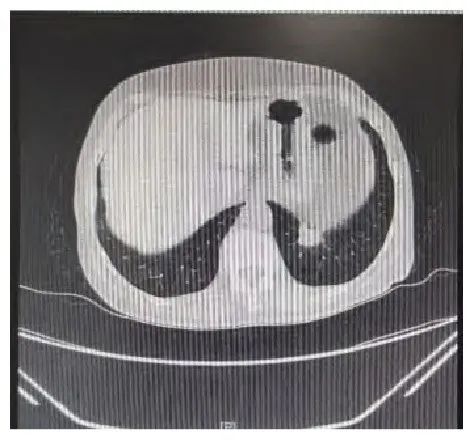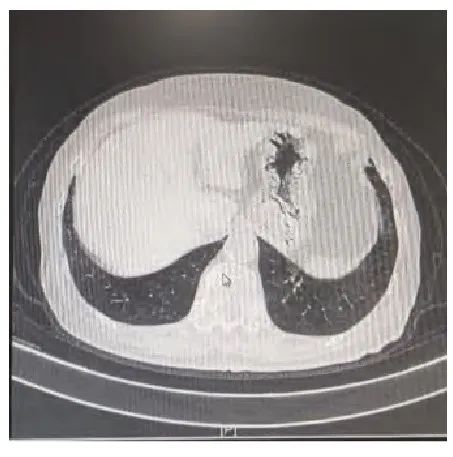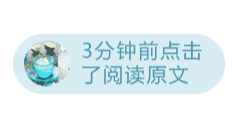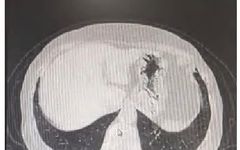Professor Yan Guizhen’s Experience in Treating Pulmonary Nodules Using the Principle of Supporting the Right and Expelling Pathogenic FactorsChen Guijing, Wang Chun’e, Yan GuizhenFujian University of Traditional Chinese Medicine Affiliated Second People’s Hospital
Abstract:This article introduces Professor Yan Guizhen’s experience in treating pulmonary nodules. He believes that pulmonary nodules often belong to the pattern of deficiency with excess signs, with the etiology and pathogenesis being deficiency of both the lung and spleen, leading to the accumulation of phlegm, blood stasis, and toxins. Therefore, in treating pulmonary nodules, he advocates principles of strengthening the spleen and benefiting the lung, clearing heat and resolving phlegm, detoxifying and dispersing nodules, and has formulated a self-designed formula for supporting the right and detoxifying to achieve good therapeutic effects. A typical case is included for verification.
Keywords:Yan Guizhen; pulmonary nodules; supporting the right and expelling pathogenic factors; expert experience;
Classification Number:R259; R249
Pulmonary nodules are defined as focal, round, solid or subsolid shadows in the lung with a density increase, measuring ≤3 cm on imaging, which can be classified as solitary or multiple [1]. With the advancement of imaging technology, the detection rate of pulmonary nodules has significantly increased. Modern medicine generally considers the etiology of pulmonary nodules to be complex and diverse, with causes including infections, inflammation, tuberculosis, old lesions, and fungi, all of which can lead to the formation of pulmonary nodules. Most patients with pulmonary nodules exhibit no obvious symptoms, making it easy to miss the treatment opportunity for some early malignant pulmonary nodules that develop insidiously. By the time they progress rapidly, the prognosis is poor, affecting the quality of life of patients. Early diagnosis and treatment are key to improving prognosis. Currently, there is no effective treatment for pulmonary nodules in Western medicine, but in Traditional Chinese Medicine (TCM), guided by the holistic diagnostic thinking and adhering to the concepts of “preventing disease before it occurs” and “preventing changes in existing diseases,” it is of great significance to improve clinical symptoms in patients with pulmonary nodules and alleviate their anxiety.Professor Yan is a renowned TCM physician in Fujian Province, with over 50 years of clinical experience in treating common and frequently occurring diseases in the respiratory system. He is skilled in using TCM dialectical thinking to treat refractory diseases of the respiratory system and has unique insights into the TCM treatment of pulmonary nodules. The author has learned from Professor Yan and summarizes his experiences as follows for mutual encouragement. 1. TCM Etiology and Pathogenesis1.1 Invasion of External Pathogenic FactorsAs stated in the “Lingshu: Nine Needles Theory,” “The lung is the cover of the five organs and six bowels,” indicating that the lung is situated at a high position among the five organs and six bowels, and is often referred to as the “canopy.” It communicates with the external natural air through the nasal passages, making it susceptible to the invasion of the six excesses, hence the saying that the lung is a delicate organ. The lung lobes are tender and fragile, intolerant to various external pathogenic factors, and easily affected by them. Professor Yan believes that the main inducement for the occurrence of pulmonary nodules is the inhalation of toxic air. The main reasons can be summarized as follows: (1) Invasion of external pathogens, which enter the lung and, if untreated, lead to the disruption of the body’s qi, blood, yin, and yang, resulting in the accumulation of phlegm and blood stasis, which then transforms into pulmonary nodules. (2) The current environmental pollution, such as car exhaust, dust, and certain chemicals, leads to the inhalation of dirty dust and other pathogenic factors that attach to the skin and limbs, accumulating in the lung’s meridians, causing dysfunction in the circulation of qi, blood, and body fluids. “The lung governs qi and controls respiration,” as stated in the “Suwen: Six Qi and Organ Images,” emphasizes that “the lung is the source of qi.” When lung qi is deficient, the distribution of body fluids is abnormal, leading to the stagnation of fluids and the formation of phlegm, which obstructs the local circulation of qi and blood, resulting in the formation of stasis. The combination of toxic air and these three factors leads to the accumulation of pulmonary nodules.1.2 Improper DietThe spleen and stomach are the foundation of postnatal life and the source of qi and blood production, primarily responsible for the transformation and transportation of the essence of food and the metabolism of waste such as phlegm and dampness. Due to concerns about the safety of modern food and drugs, many additives, preservatives, hormones, and ripening agents are present in food, all of which are considered toxic pathogenic factors. Frequent consumption of these toxic foods can damage the function of the spleen and stomach. When the spleen and stomach are impaired, the foundation of postnatal life is compromised, leading to insufficient nourishment of the lung, making it weak and unable to expel or resist pathogens, causing patients to be easily affected by external pathogens due to dietary and environmental factors, leading to the accumulation of phlegm. Dysfunction in the spleen and stomach can easily produce phlegm and dampness, and prolonged stagnation can lead to the formation of damp-heat toxins. When damp-heat toxins obstruct a certain organ, it can cause qi and blood circulation disorders, leading to pulmonary nodules or even tumors. The “Lingshu: The Beginning of All Diseases” states, “When blood coagulates and does not disperse, body fluids become thick and do not drain, all will accumulate.” The combination of phlegm, blood stasis, and damp-heat toxins can lead to dysfunction in the circulation of qi and blood in various organs, resulting in weakness and dysfunction of multiple organs.1.3 Constitutional DeficiencyIt is said that “when righteous qi is stored within, evil cannot invade; where evil qi gathers, its qi must be deficient.” If the body’s righteous qi is abundant, even if evil is encountered, the strong righteous qi can expel it. However, if the body’s righteous qi is insufficient, combined with the lung’s delicacy, it is easily affected by evil, and when evil gathers in a deficient area, it remains and does not disperse, leading to phlegm and stasis obstructing the meridians, resulting in the formation of nodules, which can even transform into cancer.1.4 Other FactorsProfessor Yan has clinically observed that patients with rheumatic immune system diseases are prone to develop nodules, which in TCM is referred to as “Wang Bi.” The etiology of this disease is often due to the obstruction of joints by wind, cold, dampness, and heat. If these evils enter the body, they can obstruct the organs and meridians, accumulating in the lungs and forming nodules. Additionally, emotional factors can also lead to the frequent occurrence of nodules, especially in patients with high work and life stress, and those who are easily anxious and tense, particularly common in female patients. When the liver is out of balance, the flow of qi is obstructed, leading to stagnation. Stagnation of qi leads to dampness not being transformed, and dampness accumulation leads to phlegm, resulting in phlegm and qi stagnation. Prolonged qi stagnation affects the circulation of qi, blood, and body fluids in all organs, leading to the accumulation of pathological products and the formation of nodules.
1. TCM Etiology and Pathogenesis1.1 Invasion of External Pathogenic FactorsAs stated in the “Lingshu: Nine Needles Theory,” “The lung is the cover of the five organs and six bowels,” indicating that the lung is situated at a high position among the five organs and six bowels, and is often referred to as the “canopy.” It communicates with the external natural air through the nasal passages, making it susceptible to the invasion of the six excesses, hence the saying that the lung is a delicate organ. The lung lobes are tender and fragile, intolerant to various external pathogenic factors, and easily affected by them. Professor Yan believes that the main inducement for the occurrence of pulmonary nodules is the inhalation of toxic air. The main reasons can be summarized as follows: (1) Invasion of external pathogens, which enter the lung and, if untreated, lead to the disruption of the body’s qi, blood, yin, and yang, resulting in the accumulation of phlegm and blood stasis, which then transforms into pulmonary nodules. (2) The current environmental pollution, such as car exhaust, dust, and certain chemicals, leads to the inhalation of dirty dust and other pathogenic factors that attach to the skin and limbs, accumulating in the lung’s meridians, causing dysfunction in the circulation of qi, blood, and body fluids. “The lung governs qi and controls respiration,” as stated in the “Suwen: Six Qi and Organ Images,” emphasizes that “the lung is the source of qi.” When lung qi is deficient, the distribution of body fluids is abnormal, leading to the stagnation of fluids and the formation of phlegm, which obstructs the local circulation of qi and blood, resulting in the formation of stasis. The combination of toxic air and these three factors leads to the accumulation of pulmonary nodules.1.2 Improper DietThe spleen and stomach are the foundation of postnatal life and the source of qi and blood production, primarily responsible for the transformation and transportation of the essence of food and the metabolism of waste such as phlegm and dampness. Due to concerns about the safety of modern food and drugs, many additives, preservatives, hormones, and ripening agents are present in food, all of which are considered toxic pathogenic factors. Frequent consumption of these toxic foods can damage the function of the spleen and stomach. When the spleen and stomach are impaired, the foundation of postnatal life is compromised, leading to insufficient nourishment of the lung, making it weak and unable to expel or resist pathogens, causing patients to be easily affected by external pathogens due to dietary and environmental factors, leading to the accumulation of phlegm. Dysfunction in the spleen and stomach can easily produce phlegm and dampness, and prolonged stagnation can lead to the formation of damp-heat toxins. When damp-heat toxins obstruct a certain organ, it can cause qi and blood circulation disorders, leading to pulmonary nodules or even tumors. The “Lingshu: The Beginning of All Diseases” states, “When blood coagulates and does not disperse, body fluids become thick and do not drain, all will accumulate.” The combination of phlegm, blood stasis, and damp-heat toxins can lead to dysfunction in the circulation of qi and blood in various organs, resulting in weakness and dysfunction of multiple organs.1.3 Constitutional DeficiencyIt is said that “when righteous qi is stored within, evil cannot invade; where evil qi gathers, its qi must be deficient.” If the body’s righteous qi is abundant, even if evil is encountered, the strong righteous qi can expel it. However, if the body’s righteous qi is insufficient, combined with the lung’s delicacy, it is easily affected by evil, and when evil gathers in a deficient area, it remains and does not disperse, leading to phlegm and stasis obstructing the meridians, resulting in the formation of nodules, which can even transform into cancer.1.4 Other FactorsProfessor Yan has clinically observed that patients with rheumatic immune system diseases are prone to develop nodules, which in TCM is referred to as “Wang Bi.” The etiology of this disease is often due to the obstruction of joints by wind, cold, dampness, and heat. If these evils enter the body, they can obstruct the organs and meridians, accumulating in the lungs and forming nodules. Additionally, emotional factors can also lead to the frequent occurrence of nodules, especially in patients with high work and life stress, and those who are easily anxious and tense, particularly common in female patients. When the liver is out of balance, the flow of qi is obstructed, leading to stagnation. Stagnation of qi leads to dampness not being transformed, and dampness accumulation leads to phlegm, resulting in phlegm and qi stagnation. Prolonged qi stagnation affects the circulation of qi, blood, and body fluids in all organs, leading to the accumulation of pathological products and the formation of nodules. 2. Summary of Clinical Experience2.1 Treatment CharacteristicsProfessor Yan believes that pulmonary nodules often belong to the pattern of deficiency with excess signs, with the main etiology and pathogenesis being deficiency of both the lung and spleen, leading to the accumulation of phlegm, blood stasis, and toxins. Therefore, he advocates principles of strengthening the spleen and benefiting the lung, clearing heat and resolving phlegm, detoxifying and dispersing nodules, and has formulated a self-designed formula for supporting the right and dispersing nodules. Professor Yan believes that the treatment of pulmonary nodules can be divided into the following aspects: (1) If the nodules are discovered early, are light in color, and have clear edges, they are more likely to be inflammatory nodules, and the treatment should primarily focus on clearing heat, detoxifying, and resolving stasis, with supporting qi as a secondary approach; (2) If the nodules are pure ground-glass nodules, or if there are uneven particles within the nodules, or if the edges are unclear with slight spiculation, both supporting the right and expelling evil should be emphasized; (3) If the patient is older and has a poor constitution, and Western medicine suggests short-term observation followed by surgery, TCM should primarily focus on supporting the right, with phlegm resolution and dispersing nodules as a secondary approach, providing treatment during the perioperative period.2.2 Medication Experience2.2.1 Supporting the Right and Expelling Evil, Strengthening the Spleen and Benefiting Qi. The “Lingshu: Nutritional and Health Meetings” states, “People receive qi from grains, which enters the stomach and is transmitted to the lungs; all five organs and six bowels receive qi,” emphasizing the importance of the spleen and lung.Professor Yan often uses large doses of Huang Qi (Astragalus) and Dang Shen (Codonopsis) as the main herbs for supporting the right. Huang Qi (also known as Huangqi, Membranous Milk Vetch) is a plant of the legume family, and Li Shizhen recorded in the “Compendium of Materia Medica”: “Qi is long, Huang Qi is yellow, and it is the best among tonics, hence the name.” The “Compendium of Materia Medica” states that Huang Qi “supplements the deficiency of men, and is beneficial for the five laborious conditions.” According to the five elements theory, the spleen and lung have a mother-son relationship; “the mother nourishes the son, and if the son is deficient, the mother cannot be nourished.” Therefore, Professor Yan often uses methods to strengthen the spleen and benefit qi to replenish the qi of the mother organ, the spleen and stomach, to maintain the lung’s function of dispersing and descending, with dosages reaching over 30g. Active components such as Astragaloside, Huang Qi polysaccharides, and Astragalus flavonoids have been isolated from Huang Qi, and modern pharmacological studies indicate that they possess anti-inflammatory, tumor growth inhibition, immune function enhancement, targeted regulation of tumor microenvironment cells, and inhibition of inflammatory responses in the tumor microenvironment, inducing apoptosis of tumor cells [2]. Dang Shen is sweet and neutral, with a gentle qi-replenishing effect, specifically beneficial for the qi of the spleen and lung. The chemical components of Dang Shen mainly include polysaccharides, alkaloids, flavonoids, and acids, which have various pharmacological effects such as regulating blood sugar, promoting hematopoiesis, anti-fatigue, enhancing immune function, and inhibiting tumor cell growth [3]. Huang Qi and Dang Shen are commonly used by Professor Yan, complementing each other and working synergistically to achieve the effect of supporting the right and expelling evil.2.2.2 Clearing Heat and Detoxifying, Softening Hardness and Dispersing Nodules. Professor Yan believes that nodules are often formed due to the obstruction of phlegm, blood stasis, and damp-heat toxins. Therefore, while treating both the root and branch, strengthening the spleen and benefiting the lung, it is necessary to expel evil toxins and disperse nodules.Professor Yan commonly uses heat-clearing and detoxifying herbs such as Pu Gong Ying (Dandelion), Long Kui (Black Nightshade), Bai Hua She She Cao (Oldenlandia), Yu Xing Cao (Houttuynia), Shan Ci Gu (Parasitic Plant), and Zhong Lou (Rhizoma Paridis). Modern studies have shown that heat-clearing and detoxifying herbs often have effects such as antipyretic, anti-inflammatory, anti-allergic, influencing immune function, and anti-tumor effects [4]. Professor Yan frequently uses herbs like Chuan Xin Lian (Andrographis), Ban Bian Lian (Lobelia), Yu Xing Cao, Long Kui, and Bai Hua She She Cao, which can effectively combat cancer cells. Cooling herbs should not be used excessively, so he often alternates between 1-2 types of heat-clearing and detoxifying herbs to avoid developing resistance. Shan Ci Gu is sweet and slightly warm, softening hardness and dispersing nodules. TCM believes that pulmonary nodules are formed due to qi stagnation, phlegm condensation, blood stasis, and the accumulation of toxic qi in the lung, so Shan Ci Gu can resolve phlegm and disperse nodules. Zhong Lou, also known as Seven-leaf One-branch Flower, has effects of clearing heat, detoxifying, and reducing swelling and pain. The “Essentials of Medicinal Herbs” mentions its ability to “nourish blood, promote qi, strengthen the kidney, and eliminate toxins,” while the “Compendium of Materia Medica” records its discussion on “nourishing the spleen and elevating the clear qi of the stomach,” indicating the broad application of Zhong Lou saponins in anti-tumor and immune therapy [5]. For patients with a long course of disease, where phlegm, blood stasis, and toxic evils have accumulated in the lung, appropriate use of insect-based herbs to expel evil and search for the meridians, such as Wu Gong (Centipede) for detoxification and dispersing nodules, is recommended. Studies have shown that extracts from Wu Gong have a concentration-dependent inhibitory effect on human lung cancer A549 cells, inducing apoptosis and effectively inhibiting tumor cell growth [6]. Wu Gong is toxic, so Professor Yan often adds a small amount to large doses of tonifying herbs to achieve the effect of detoxification and dispersing nodules.2.2.3 Clinical Adjustments. In addition to the aforementioned herbs, adjustments are made according to the symptoms in clinical practice.For example, if there is significant coughing and phlegm, herbs like Xing Ren (Apricot Kernel), Bai Qian (Cynanchum), and Mi Zi (Honeyed Purple Aster) can be added to disperse lung qi and stop cough; if accompanied by wheezing and shortness of breath, herbs like Mi Ma Huang (Honeyed Ephedra), Zi Su Zi (Perilla Seed), and Di Long (Earthworm) can be added to disperse lung qi and relieve spasms; if there is throat itching, herbs like Ji Zhi (Tribulus) can be added to dispel wind and relieve itching. If there are oral ulcers, Huang Lian (Coptis) and Feng Fang (Beehive) can be added to clear heat, drain fire, and relieve pain.
2. Summary of Clinical Experience2.1 Treatment CharacteristicsProfessor Yan believes that pulmonary nodules often belong to the pattern of deficiency with excess signs, with the main etiology and pathogenesis being deficiency of both the lung and spleen, leading to the accumulation of phlegm, blood stasis, and toxins. Therefore, he advocates principles of strengthening the spleen and benefiting the lung, clearing heat and resolving phlegm, detoxifying and dispersing nodules, and has formulated a self-designed formula for supporting the right and dispersing nodules. Professor Yan believes that the treatment of pulmonary nodules can be divided into the following aspects: (1) If the nodules are discovered early, are light in color, and have clear edges, they are more likely to be inflammatory nodules, and the treatment should primarily focus on clearing heat, detoxifying, and resolving stasis, with supporting qi as a secondary approach; (2) If the nodules are pure ground-glass nodules, or if there are uneven particles within the nodules, or if the edges are unclear with slight spiculation, both supporting the right and expelling evil should be emphasized; (3) If the patient is older and has a poor constitution, and Western medicine suggests short-term observation followed by surgery, TCM should primarily focus on supporting the right, with phlegm resolution and dispersing nodules as a secondary approach, providing treatment during the perioperative period.2.2 Medication Experience2.2.1 Supporting the Right and Expelling Evil, Strengthening the Spleen and Benefiting Qi. The “Lingshu: Nutritional and Health Meetings” states, “People receive qi from grains, which enters the stomach and is transmitted to the lungs; all five organs and six bowels receive qi,” emphasizing the importance of the spleen and lung.Professor Yan often uses large doses of Huang Qi (Astragalus) and Dang Shen (Codonopsis) as the main herbs for supporting the right. Huang Qi (also known as Huangqi, Membranous Milk Vetch) is a plant of the legume family, and Li Shizhen recorded in the “Compendium of Materia Medica”: “Qi is long, Huang Qi is yellow, and it is the best among tonics, hence the name.” The “Compendium of Materia Medica” states that Huang Qi “supplements the deficiency of men, and is beneficial for the five laborious conditions.” According to the five elements theory, the spleen and lung have a mother-son relationship; “the mother nourishes the son, and if the son is deficient, the mother cannot be nourished.” Therefore, Professor Yan often uses methods to strengthen the spleen and benefit qi to replenish the qi of the mother organ, the spleen and stomach, to maintain the lung’s function of dispersing and descending, with dosages reaching over 30g. Active components such as Astragaloside, Huang Qi polysaccharides, and Astragalus flavonoids have been isolated from Huang Qi, and modern pharmacological studies indicate that they possess anti-inflammatory, tumor growth inhibition, immune function enhancement, targeted regulation of tumor microenvironment cells, and inhibition of inflammatory responses in the tumor microenvironment, inducing apoptosis of tumor cells [2]. Dang Shen is sweet and neutral, with a gentle qi-replenishing effect, specifically beneficial for the qi of the spleen and lung. The chemical components of Dang Shen mainly include polysaccharides, alkaloids, flavonoids, and acids, which have various pharmacological effects such as regulating blood sugar, promoting hematopoiesis, anti-fatigue, enhancing immune function, and inhibiting tumor cell growth [3]. Huang Qi and Dang Shen are commonly used by Professor Yan, complementing each other and working synergistically to achieve the effect of supporting the right and expelling evil.2.2.2 Clearing Heat and Detoxifying, Softening Hardness and Dispersing Nodules. Professor Yan believes that nodules are often formed due to the obstruction of phlegm, blood stasis, and damp-heat toxins. Therefore, while treating both the root and branch, strengthening the spleen and benefiting the lung, it is necessary to expel evil toxins and disperse nodules.Professor Yan commonly uses heat-clearing and detoxifying herbs such as Pu Gong Ying (Dandelion), Long Kui (Black Nightshade), Bai Hua She She Cao (Oldenlandia), Yu Xing Cao (Houttuynia), Shan Ci Gu (Parasitic Plant), and Zhong Lou (Rhizoma Paridis). Modern studies have shown that heat-clearing and detoxifying herbs often have effects such as antipyretic, anti-inflammatory, anti-allergic, influencing immune function, and anti-tumor effects [4]. Professor Yan frequently uses herbs like Chuan Xin Lian (Andrographis), Ban Bian Lian (Lobelia), Yu Xing Cao, Long Kui, and Bai Hua She She Cao, which can effectively combat cancer cells. Cooling herbs should not be used excessively, so he often alternates between 1-2 types of heat-clearing and detoxifying herbs to avoid developing resistance. Shan Ci Gu is sweet and slightly warm, softening hardness and dispersing nodules. TCM believes that pulmonary nodules are formed due to qi stagnation, phlegm condensation, blood stasis, and the accumulation of toxic qi in the lung, so Shan Ci Gu can resolve phlegm and disperse nodules. Zhong Lou, also known as Seven-leaf One-branch Flower, has effects of clearing heat, detoxifying, and reducing swelling and pain. The “Essentials of Medicinal Herbs” mentions its ability to “nourish blood, promote qi, strengthen the kidney, and eliminate toxins,” while the “Compendium of Materia Medica” records its discussion on “nourishing the spleen and elevating the clear qi of the stomach,” indicating the broad application of Zhong Lou saponins in anti-tumor and immune therapy [5]. For patients with a long course of disease, where phlegm, blood stasis, and toxic evils have accumulated in the lung, appropriate use of insect-based herbs to expel evil and search for the meridians, such as Wu Gong (Centipede) for detoxification and dispersing nodules, is recommended. Studies have shown that extracts from Wu Gong have a concentration-dependent inhibitory effect on human lung cancer A549 cells, inducing apoptosis and effectively inhibiting tumor cell growth [6]. Wu Gong is toxic, so Professor Yan often adds a small amount to large doses of tonifying herbs to achieve the effect of detoxification and dispersing nodules.2.2.3 Clinical Adjustments. In addition to the aforementioned herbs, adjustments are made according to the symptoms in clinical practice.For example, if there is significant coughing and phlegm, herbs like Xing Ren (Apricot Kernel), Bai Qian (Cynanchum), and Mi Zi (Honeyed Purple Aster) can be added to disperse lung qi and stop cough; if accompanied by wheezing and shortness of breath, herbs like Mi Ma Huang (Honeyed Ephedra), Zi Su Zi (Perilla Seed), and Di Long (Earthworm) can be added to disperse lung qi and relieve spasms; if there is throat itching, herbs like Ji Zhi (Tribulus) can be added to dispel wind and relieve itching. If there are oral ulcers, Huang Lian (Coptis) and Feng Fang (Beehive) can be added to clear heat, drain fire, and relieve pain. 3. Case ExampleA 76-year-old female patient was first diagnosed on November 26, 2020. Chief complaint: A left lung nodule was found during a physical examination over a month ago. Current medical history: The patient’s family reported that a CT scan of the lung revealed a left lung nodule a month ago. Considering the patient’s advanced age, the family was concerned that she might not tolerate invasive procedures in Western medicine and sought TCM treatment due to worries about the nodule’s further development. Symptoms observed: Occasional cough, dry mouth and thirst, difficulty in bowel movements, and acceptable appetite and sleep. Physical examination: Dark red tongue, yellow coating, thin pulse, clear breath sounds in both lungs. Past medical history: History of “chronic heart failure,” currently under control. Auxiliary examination: Chest CT (see Figure 1): (1) A mass shadow in the upper lobe of the left lung, approximately 2.2×1.8 cm, suspected to be malignant, suggesting further examination or active anti-inflammatory treatment followed by re-examination for comparison: scattered chronic inflammation in both lungs, with old lesions in the apical posterior segment of the left lung. (2) Aortic and coronary artery sclerosis. After comprehensive diagnosis, the pattern was identified as phlegm and blood stasis obstructing the lung, with deficiency of both lung and kidney; treatment focused on tonifying the lung, strengthening the spleen, and benefiting the kidney, activating blood, resolving phlegm, and dispersing nodules. Professor Yan suggested that the patient take TCM for three months; if the nodule could be resolved, that would be best; if not, tonifying the spleen and benefiting qi could enhance her constitution. Prescription: Dang Shen 30g, Huang Qi 30g, Mai Dong (Ophiopogon) 9g, Wu Wei Zi (Schisandra) 9g, Shan Tao Ren (Peach Kernel) 9g, Lu Lu Tong (Liquidambar) 10g, Shan Ci Gu 10g, Wu Gong 5g, Zhi Chen Pi (Aged Tangerine Peel) 9g, Zhi Qiao (Bitter Orange) 9g, Huo Ma Ren (Hemp Seed) 15g, Bai Zhu (Atractylodes) 9g, Pu Gong Ying 30g, Ku Xing Ren (Bitter Apricot Kernel) 9g, Gan Cao (Licorice) 3g, ×4 doses, one dose per day, decocted in water, taken half an hour after breakfast and dinner, and advised the patient and family to relax. Second diagnosis (November 30): The patient reported improvement in symptoms after taking the medicine, with better bowel movements, but appetite and sleep were still lacking. Based on the previous prescription, Huo Ma Ren and Zhi Qiao were removed, and Jiang Ban Xia (Pinellia) 9g, Jian Qu (Fermented Wheat) 10g, and Fang Feng (Siler) 9g, and Suan Zao Ren (Sour Jujube Seed) 20g were added. A total of 6 doses, decocted in water, taken warm after breakfast and dinner for 30 minutes. Third diagnosis (December 10): The patient reported improved appetite but still had poor sleep and recent oral ulcers. The second prescription was adjusted by removing Jian Qu and adding Huang Lian 3g and Feng Fang 5g, totaling 7 doses, decocted in water, taken warm after breakfast and dinner for 30 minutes. The patient has adhered to regular follow-ups since the initial diagnosis, adjusting the prescription according to symptoms. In November 2021, a full-body examination and re-examination of the chest CT (see Figure 2) showed that the original left lung lower lobe nodule was no longer visible.
3. Case ExampleA 76-year-old female patient was first diagnosed on November 26, 2020. Chief complaint: A left lung nodule was found during a physical examination over a month ago. Current medical history: The patient’s family reported that a CT scan of the lung revealed a left lung nodule a month ago. Considering the patient’s advanced age, the family was concerned that she might not tolerate invasive procedures in Western medicine and sought TCM treatment due to worries about the nodule’s further development. Symptoms observed: Occasional cough, dry mouth and thirst, difficulty in bowel movements, and acceptable appetite and sleep. Physical examination: Dark red tongue, yellow coating, thin pulse, clear breath sounds in both lungs. Past medical history: History of “chronic heart failure,” currently under control. Auxiliary examination: Chest CT (see Figure 1): (1) A mass shadow in the upper lobe of the left lung, approximately 2.2×1.8 cm, suspected to be malignant, suggesting further examination or active anti-inflammatory treatment followed by re-examination for comparison: scattered chronic inflammation in both lungs, with old lesions in the apical posterior segment of the left lung. (2) Aortic and coronary artery sclerosis. After comprehensive diagnosis, the pattern was identified as phlegm and blood stasis obstructing the lung, with deficiency of both lung and kidney; treatment focused on tonifying the lung, strengthening the spleen, and benefiting the kidney, activating blood, resolving phlegm, and dispersing nodules. Professor Yan suggested that the patient take TCM for three months; if the nodule could be resolved, that would be best; if not, tonifying the spleen and benefiting qi could enhance her constitution. Prescription: Dang Shen 30g, Huang Qi 30g, Mai Dong (Ophiopogon) 9g, Wu Wei Zi (Schisandra) 9g, Shan Tao Ren (Peach Kernel) 9g, Lu Lu Tong (Liquidambar) 10g, Shan Ci Gu 10g, Wu Gong 5g, Zhi Chen Pi (Aged Tangerine Peel) 9g, Zhi Qiao (Bitter Orange) 9g, Huo Ma Ren (Hemp Seed) 15g, Bai Zhu (Atractylodes) 9g, Pu Gong Ying 30g, Ku Xing Ren (Bitter Apricot Kernel) 9g, Gan Cao (Licorice) 3g, ×4 doses, one dose per day, decocted in water, taken half an hour after breakfast and dinner, and advised the patient and family to relax. Second diagnosis (November 30): The patient reported improvement in symptoms after taking the medicine, with better bowel movements, but appetite and sleep were still lacking. Based on the previous prescription, Huo Ma Ren and Zhi Qiao were removed, and Jiang Ban Xia (Pinellia) 9g, Jian Qu (Fermented Wheat) 10g, and Fang Feng (Siler) 9g, and Suan Zao Ren (Sour Jujube Seed) 20g were added. A total of 6 doses, decocted in water, taken warm after breakfast and dinner for 30 minutes. Third diagnosis (December 10): The patient reported improved appetite but still had poor sleep and recent oral ulcers. The second prescription was adjusted by removing Jian Qu and adding Huang Lian 3g and Feng Fang 5g, totaling 7 doses, decocted in water, taken warm after breakfast and dinner for 30 minutes. The patient has adhered to regular follow-ups since the initial diagnosis, adjusting the prescription according to symptoms. In November 2021, a full-body examination and re-examination of the chest CT (see Figure 2) showed that the original left lung lower lobe nodule was no longer visible.

Figure 1 (October 16, 2020)

Figure 2 (November 12, 2021)Comment: This patient is a typical case of pulmonary nodules, discovered during a physical examination with no significant clinical respiratory symptoms, only occasional cough, and no other positive lung signs. At the initial diagnosis, the chest CT showed a left lung lower lobe nodule measuring 2.2 cm × 1.8 cm, with a possibility of malignancy. The patient’s dark red tongue and thin pulse indicated blood stasis obstruction. Additionally, the patient had a history of chronic heart failure, with blood stasis being a continuous issue throughout the development of chronic heart failure. The patient is an elderly female with a weak constitution, with the five organs and six bowels lacking nourishment, leading to dysfunction in the circulation of qi, blood, and body fluids, with pathogenic evils lingering in the lung, causing the stagnation of phlegm, blood stasis, and damp-heat toxins, which accumulate in the lung’s meridians and form nodules. The deficiency of spleen qi leads to dysfunction in the transformation and transportation of phlegm and dampness, resulting in the internal obstruction of phlegm and dampness, qi and blood circulation disorders, and the internal generation of blood stasis. Additionally, the accumulation of toxic substances leads to the formation of damp-heat toxins, which combine and accumulate in the lung, forming nodules. Professor Yan’s self-designed dispersing formula, with adjustments according to symptoms, was employed. Given the patient’s advanced age and organ deficiency, large doses of Huang Qi and Dang Shen were used to support the right and expel evil, combined with Bai Zhu and Chen Pi to strengthen the spleen and benefit the source of qi and blood production, normalizing lung and spleen functions. The patient’s history of chronic heart failure was addressed with Dang Shen, Mai Dong, and Wu Wei Zi, collectively benefiting qi and nourishing the heart. Shan Ci Gu, being sweet and cool, has effects of clearing heat, detoxifying, resolving phlegm, and dispersing nodules. A small amount of Wu Gong was added to enhance the detoxification and dispersing effects. Lu Lu Tong and Shan Tao Ren promote blood circulation, and combined with Wu Gong, they search for evils and disperse nodules. Due to the patient’s constitutional deficiency, the lung and large intestine are interrelated; when lung qi is deficient, the large intestine cannot effectively transport waste. Additionally, Huo Ma Ren and Zhi Qiao were included to moisten the intestines and promote bowel movements, while Pu Gong Ying clears heat, detoxifies, and disperses nodules, achieving a comprehensive treatment of both root and branch, nourishing the organs. This case employed the method of supporting the right and expelling evil, using large doses of spleen and lung tonics, combined with phlegm resolution, detoxification, and dispersing nodules, along with a small amount of insect-based herbs, effectively inhibiting the further enlargement of pulmonary nodules. 4. InsightsWith the development of society and the widespread application of medical imaging technology, as well as the increasing health awareness among people, more and more pulmonary nodules are being discovered clinically. Due to their potential for malignancy, they impose significant psychological burdens on patients. Professor Yan advises patients to maintain a cheerful mood, live regularly, quit smoking, exercise appropriately, and engage in deep breathing exercises to enhance lung function. He believes that pulmonary nodules often belong to the pattern of deficiency with excess signs, with the disease location in the lung, related to the spleen, liver, and kidney, where phlegm, blood stasis, and damp-heat are the main pathological factors. He advocates the principle of supporting the right and dispersing nodules for treatment, adjusting the emphasis on supporting the right and expelling evil according to the urgency of the condition, while also adjusting the patient’s constitution, providing treatments such as tonifying the lung, strengthening the spleen, benefiting qi, clearing heat, detoxifying, and activating blood to disperse nodules, effectively inhibiting the further enlargement and multiplicity of pulmonary nodules. Professor Yan has over fifty years of clinical experience, rich in practice, adhering to the teachings while being flexible and adaptable in clinical practice, adjusting prescriptions according to symptoms, which is worth our serious study and understanding.References[1] Zhang Xiaojun, Bai Li, Jin Faguang, et al. Expert Consensus on the Diagnosis and Treatment of Pulmonary Nodules in China (2018 Edition) [J]. Chinese Journal of Tuberculosis and Respiratory Diseases, 2018, 41(10): 763-771.[2] Jiang Mingwen. Study on the Antitumor Efficacy of Active Ingredients from Huang Qi [D]. Yanbian University, 2021.[3] Huang Yuanyuan, Zhang Yuan, Kang Liping, et al. Research Progress on Chemical Components and Pharmacological Activities of Codonopsis [J]. Chinese Herbal Medicine, 2018, 49(01): 239-250.[4] Li Ji, Li Xiang, Gao Yanyu, et al. Research Progress on the Effects of Heat-Clearing and Detoxifying Drugs on Tumor Treatment and Their Signal Pathway Regulation [J]. Chinese Journal of Experimental Traditional Chinese Medicine, 2019, 25(24): 188-195.[5] Zhang Xiaoli, Liu Qin, Liu Baorui. Research Progress on the Antitumor and Immune Microenvironment Regulation of Zhong Lou Saponins [J]. Shaanxi Traditional Chinese Medicine, 2021, 42(11): 1640-1643.[6] Chen Yuan, Ai Xiaojia, Wang Zhiqi, et al. In Vivo and In Vitro Experimental Study on the Anticancer Activity of Centipede Extracts [J]. Chinese Journal of Traditional Chinese Medicine Information, 2016, 23(05): 61-63.End
4. InsightsWith the development of society and the widespread application of medical imaging technology, as well as the increasing health awareness among people, more and more pulmonary nodules are being discovered clinically. Due to their potential for malignancy, they impose significant psychological burdens on patients. Professor Yan advises patients to maintain a cheerful mood, live regularly, quit smoking, exercise appropriately, and engage in deep breathing exercises to enhance lung function. He believes that pulmonary nodules often belong to the pattern of deficiency with excess signs, with the disease location in the lung, related to the spleen, liver, and kidney, where phlegm, blood stasis, and damp-heat are the main pathological factors. He advocates the principle of supporting the right and dispersing nodules for treatment, adjusting the emphasis on supporting the right and expelling evil according to the urgency of the condition, while also adjusting the patient’s constitution, providing treatments such as tonifying the lung, strengthening the spleen, benefiting qi, clearing heat, detoxifying, and activating blood to disperse nodules, effectively inhibiting the further enlargement and multiplicity of pulmonary nodules. Professor Yan has over fifty years of clinical experience, rich in practice, adhering to the teachings while being flexible and adaptable in clinical practice, adjusting prescriptions according to symptoms, which is worth our serious study and understanding.References[1] Zhang Xiaojun, Bai Li, Jin Faguang, et al. Expert Consensus on the Diagnosis and Treatment of Pulmonary Nodules in China (2018 Edition) [J]. Chinese Journal of Tuberculosis and Respiratory Diseases, 2018, 41(10): 763-771.[2] Jiang Mingwen. Study on the Antitumor Efficacy of Active Ingredients from Huang Qi [D]. Yanbian University, 2021.[3] Huang Yuanyuan, Zhang Yuan, Kang Liping, et al. Research Progress on Chemical Components and Pharmacological Activities of Codonopsis [J]. Chinese Herbal Medicine, 2018, 49(01): 239-250.[4] Li Ji, Li Xiang, Gao Yanyu, et al. Research Progress on the Effects of Heat-Clearing and Detoxifying Drugs on Tumor Treatment and Their Signal Pathway Regulation [J]. Chinese Journal of Experimental Traditional Chinese Medicine, 2019, 25(24): 188-195.[5] Zhang Xiaoli, Liu Qin, Liu Baorui. Research Progress on the Antitumor and Immune Microenvironment Regulation of Zhong Lou Saponins [J]. Shaanxi Traditional Chinese Medicine, 2021, 42(11): 1640-1643.[6] Chen Yuan, Ai Xiaojia, Wang Zhiqi, et al. In Vivo and In Vitro Experimental Study on the Anticancer Activity of Centipede Extracts [J]. Chinese Journal of Traditional Chinese Medicine Information, 2016, 23(05): 61-63.End
Recommended Reading:
【Expert Experience】Li Yueheng’s Clinical Experience in Treating Nasopharyngeal Cancer
【Expert Experience】Li Peifang’s Experience in Treating Insomnia Based on the Theory of Regulating the Three Jiao
【Expert Experience】Professor Kuang Shixiang’s Experience in Treating Dizziness
Copyright Statement:
-
This article is sourced from “Massage and Rehabilitation Medicine” 2023.4.13, edited by Xu Yihan;Images generated by AI, please delete if infringing
-
Copyright belongs to the relevant rights holders. If there are any improper uses, please contact us.
-
This public account shares articles for learning, communication, and reference only. Please do not use them indiscriminately.

 Contact Us
Contact Us Website: http://tcm.ckcest.cn/tcmkb/pages/home_index.jspTel: 010-64089578Email: [email protected]
Website: http://tcm.ckcest.cn/tcmkb/pages/home_index.jspTel: 010-64089578Email: [email protected]

 Click the end of the article “Read the original text” to progress together!
Click the end of the article “Read the original text” to progress together!

